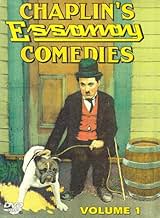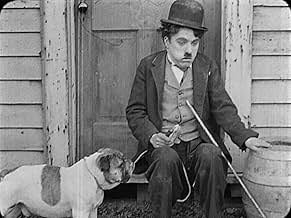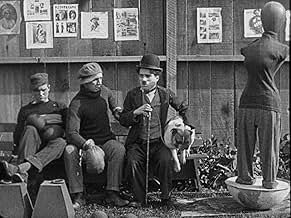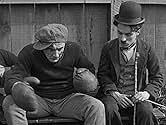The Champion
- 1915
- 31 मि
IMDb रेटिंग
6.7/10
2.9 हज़ार
आपकी रेटिंग
अपनी भाषा में प्लॉट जोड़ेंWith his bulldog, Charlie finds a good luck horseshoe as he passes a boxing camp looking for someone who can take a beating. With the horseshoe in his glove, Charlie wins and earns a fight a... सभी पढ़ेंWith his bulldog, Charlie finds a good luck horseshoe as he passes a boxing camp looking for someone who can take a beating. With the horseshoe in his glove, Charlie wins and earns a fight against the world champion.With his bulldog, Charlie finds a good luck horseshoe as he passes a boxing camp looking for someone who can take a beating. With the horseshoe in his glove, Charlie wins and earns a fight against the world champion.
- निर्देशक
- लेखक
- स्टार
Bud Jamison
- Bob Uppercut - Champion
- (बिना क्रेडिट के)
Gilbert M. 'Broncho Billy' Anderson
- Enthusiastic Fan
- (बिना क्रेडिट के)
Billy Armstrong
- Sparring Partner
- (बिना क्रेडिट के)
Lloyd Bacon
- Second Sparring Partner
- (बिना क्रेडिट के)
- …
Bill Cato
- First Sparring Partner
- (बिना क्रेडिट के)
- …
Frank Dolan
- Second Stretcher Bearer
- (बिना क्रेडिट के)
W. Coleman Elam
- Bit Role
- (बिना क्रेडिट के)
Eddie Fries
- Bit Role
- (बिना क्रेडिट के)
Daniel P. Kelleher
- Second Cop
- (बिना क्रेडिट के)
Paddy McGuire
- Sparring Partner
- (बिना क्रेडिट के)
Edna Purviance
- Trainer's Daughter
- (बिना क्रेडिट के)
Jess Robbins
- Bit Role
- (बिना क्रेडिट के)
Carl Stockdale
- Sparring Partner
- (बिना क्रेडिट के)
Ben Turpin
- Ringside Vendor
- (बिना क्रेडिट के)
Ernest Van Pelt
- Spike Dugan
- (बिना क्रेडिट के)
Leo White
- Crooked Gambler
- (बिना क्रेडिट के)
फ़ीचर्ड समीक्षाएं
'The Champion' is a nice short film by Charlie Chaplin and of course with Charlie Chaplin. Watching him I always admire his skills. I don't know if you can call it acting but whatever you call it he is great with it. This short starts as a real story but soon it can come to the moment where Chaplin can show his skills. This time in a boxing contest and the preparation before it. There are some very funny moments and most of it was not that predictable. That is the case very often in the shorts of Charlie Chaplin but not so much in this one. I also liked the way the music played together with the performances, it made the whole thing funnier. Definitely worth a watch.
Charlie Chaplin in the prize ring; his admirers will chuckle at the bare thought, and roar when they see the picture. The scenes in the training quarters are a steady laugh, but when Charlie faces his opponent in the roped arena, the fun is more than doubled. There have, doubtless, been burlesque boxing matches ever since the birth of the drama, but this one knocks them all out. It is a three-round "go" that grows in excitement and hilarity at every blow struck. While it must be admitted that Charlies wins the championship on a foul (with the help of his bull dog), everyone will be delighted with the result. A two-reel side-splitter. - The Moving Picture World, March 27, 1915
Chaplin's third Essanay picture and he finally appears to have found his feet with the new studio. Chaplin's tramp, destitute and famished spots a sign offering money to act as a sparring partner. He watches as three men go in before him and return battered and bruised. Chaplin however has a trick up his sleeve or rather in his glove; a lucky horseshoe, which he uses to knock out his larger, more adept opponent. Spotting his potential a trainer prepares the slight Chaplin for a big fight against the champion Bob Uppercut (Bud Jamison) but Chaplin has other things on his mind, namely the trainer's daughter Edna Purviance.
I was so glad that this film was good. I was really disappointed with Chaplin's first two Essanay films His New Job and A Night Out. This is a real return to form. The idea was actually taken from a Fred Karno sketch that Chaplin performed before entering the movie industry. Perhaps one of the reasons for the film's success is that Chaplin knew what he was doing before he went in rather than partially making it up as he went along.
The film really shows its age with its inter-titles. There wasn't one occasion where I understood every word! But you have to remember that this film is 97 years old and language changes. Another thing that changes is people's attitudes and sensibilities towards kissing. It's hard to believe now but Hollywood once enforced a self censorship ruling that meant that no on screen kiss could last more than a couple of seconds. Although made in pre-code Hollywood, Chaplin got round this type of censorship by having his Tramp kiss Edna from behind a large beer bottle. It's a clever device that works around censorship.
The film is much slower and more measured than much of Chaplin's other work of the period and especially the work of Keystone. The opening scene in which Chaplin shares a hot dog with his equally starving dog is both very sweet and very slow and reminiscent of his later work. It's a complete opposite of his previous Keystone films.
The highlight of the film is undoubtedly the boxing. Watching Chaplin train in his trademark bowler hat is brilliant and the big fight itself is hilarious and extremely well choreographed. Chaplin and Jamison spend half the fight either falling over or in embraces, punching themselves in the face and the umpire obviously gets a few punches thrown his way too. Raging Bull this is not. You have to feel that the film is a precursor to Chaplin's massively successful City Lights which features his famous boxing scene. Another highlight is the fantastic makeup and over the top fake facial hair of the film's villain Leo White, a motif of Chaplin's early work. Without dialogue you are still always sure who the bad guy is with his deep dark eyes, pale face and enormous moustache.
This film is not up there with Chaplin's later work but shows great potential. It is a marked improvement on his earlier Essanay films and introduced a lot of action into his repertoire.
www.attheback.blogspot.com
I was so glad that this film was good. I was really disappointed with Chaplin's first two Essanay films His New Job and A Night Out. This is a real return to form. The idea was actually taken from a Fred Karno sketch that Chaplin performed before entering the movie industry. Perhaps one of the reasons for the film's success is that Chaplin knew what he was doing before he went in rather than partially making it up as he went along.
The film really shows its age with its inter-titles. There wasn't one occasion where I understood every word! But you have to remember that this film is 97 years old and language changes. Another thing that changes is people's attitudes and sensibilities towards kissing. It's hard to believe now but Hollywood once enforced a self censorship ruling that meant that no on screen kiss could last more than a couple of seconds. Although made in pre-code Hollywood, Chaplin got round this type of censorship by having his Tramp kiss Edna from behind a large beer bottle. It's a clever device that works around censorship.
The film is much slower and more measured than much of Chaplin's other work of the period and especially the work of Keystone. The opening scene in which Chaplin shares a hot dog with his equally starving dog is both very sweet and very slow and reminiscent of his later work. It's a complete opposite of his previous Keystone films.
The highlight of the film is undoubtedly the boxing. Watching Chaplin train in his trademark bowler hat is brilliant and the big fight itself is hilarious and extremely well choreographed. Chaplin and Jamison spend half the fight either falling over or in embraces, punching themselves in the face and the umpire obviously gets a few punches thrown his way too. Raging Bull this is not. You have to feel that the film is a precursor to Chaplin's massively successful City Lights which features his famous boxing scene. Another highlight is the fantastic makeup and over the top fake facial hair of the film's villain Leo White, a motif of Chaplin's early work. Without dialogue you are still always sure who the bad guy is with his deep dark eyes, pale face and enormous moustache.
This film is not up there with Chaplin's later work but shows great potential. It is a marked improvement on his earlier Essanay films and introduced a lot of action into his repertoire.
www.attheback.blogspot.com
This is one of 5 Chaplin that are on the first DVD of Chaplin's Essanay Comedies. In general, compared to volume 2, the shorts on volume 1 aren't as well-made--because the DVDs are arranged chronologically. Chaplin's skill as a film maker and actor appeared to improve through his stay with Essanay Studios.
This short is not great, but compared to the previous Essanay shorts, it is a major improvement. That's because this short is more like a mini-movie and is very plot-driven--something ALL great Chaplin shorts have in common. The final boxing sequence is funny but makes no sense--just turn off your brain and enjoy.
By the way,...I like the dog in the film. Dogs like this are cool.
This short is not great, but compared to the previous Essanay shorts, it is a major improvement. That's because this short is more like a mini-movie and is very plot-driven--something ALL great Chaplin shorts have in common. The final boxing sequence is funny but makes no sense--just turn off your brain and enjoy.
By the way,...I like the dog in the film. Dogs like this are cool.
Like so many of Charlie Chaplin's early films The Champion has been subjected to a lot of tampering over the years. Depending on which print you see, the tough guy Charlie knocks out might be named Spike Dugan or Spike Henessy, his hefty opponent in the ring might be identified as Young Hippo or Bob Uppercut, leading lady Edna Purviance's presence during the training sessions may or may not be explained (in some editions she's identified as the trainer's daughter), Charlie's encounter with two cops might be deleted, and, all told, the film's running time could be anywhere from twenty minutes to as little as nine or ten. It's appalling what latter-day distributors have done to Chaplin's work; movies are renamed, scenes are rearranged or chopped out, and jokey title cards are added which are often unfunny, inappropriate and/or in poor taste. And on top of all that deliberate abuse the inevitable ravages of time and heavy usage have taken a toll on the quality of the prints themselves. Happily, however, and despite the rough treatment it has sustained, The Champion stands as one of Chaplin's funniest and most satisfying early comedies. The film boasts lots of sure-fire gags, colorful supporting players, and an especially vigorous and winning performance from the leading player himself.
During his apprenticeship at Keystone in 1914 Chaplin learned the rudiments of filmmaking from Mack Sennett, who liked his comedies low and fast. Thus, in his earliest movies Chaplin is concerned only with action and gags, and doesn't seem to care whether the viewer likes his character or not; sometimes he's an out-and-out rotter. But with this new series for the Essanay company Chaplin learned, first, to slow down a little and let things unfold as they may. More importantly, he learned to develop a sympathetic character viewers could care about.
The opening of The Champion shows Charlie sitting on a stoop with his only friend, an endearingly ugly bulldog named Spike, as they eat a meal. Charlie offers a sausage to Spike who, amusingly, chooses to eat only after the sausage has been properly seasoned. It's a charming scene and a leisurely one, and it sets an agreeable tempo. By the time the sequence is over, whether we've seen Charlie before or not, we like this poor guy and his ugly dog, and we're rooting for them. When Charlie decides to try his luck as a boxer he even manages to retain our sympathy when he employs less-than-ethical means to knock out his foe.
Later, we're troubled when Charlie appears to flirt with the idea of accepting a bribe from a crooked gambler, but ultimately the crook gets what he deserves and Charlie is more The Good Guy than ever. This sequence, in some respects, is the funniest in the entire film. Gambler Leo White is hilariously hammy, and Charlie peppers us with gags using every available prop: the paper money he grips in his mouth, the gun that points every which way, and even Leo White's villainous mustache, which Charlie reaches over and twirls one step ahead of the villain.
Everything builds towards the climactic battle. Chaplin fans taking the long view might regard this as a dry run for the big fight in City Lights, made in 1931, but for my money the boxing match in The Champion can hold its own as a great sequence in its own right. In addition to being well staged and beautifully timed, the scene features several notable participants silent film buffs will recognize. Charlie's tubby opponent in the ring is character actor Bud Jamison, at the beginning of a 30-year career supporting just about every prominent comedian of the era. In the stands meanwhile are two prominent players of the day, G. M. "Broncho Billy" Anderson and Ben Turpin. Anderson was among the very first Western stars, and also happened to be a co-founder of the Essanay company, producers of this film. Therefore Anderson was in effect Chaplin's boss, and his cameo (as a highly enthusiastic spectator) can be seen as something of a good-natured inside joke. Ben Turpin, on the other hand, had co-starred with Chaplin in his two previous comedies, but it's said that the two men didn't get along, and they went their separate ways after this point. Turpin is granted a very brief bit as a peanut vendor in the stands during the bout, clambering over spectators before he is bodily thrown out -- out of the stands, out of the film, and, in effect, out of Chaplin's orbit.
In any event, the fight makes for a funny and exciting finale, and it provides Spike the dog with one last moment of screen immortality. (Sadly, the dog was struck and killed by a car shortly after this movie was completed.) For Spike's co-star, The Champion was not only a vast improvement over his earlier work, but the first of many classic comedies.
During his apprenticeship at Keystone in 1914 Chaplin learned the rudiments of filmmaking from Mack Sennett, who liked his comedies low and fast. Thus, in his earliest movies Chaplin is concerned only with action and gags, and doesn't seem to care whether the viewer likes his character or not; sometimes he's an out-and-out rotter. But with this new series for the Essanay company Chaplin learned, first, to slow down a little and let things unfold as they may. More importantly, he learned to develop a sympathetic character viewers could care about.
The opening of The Champion shows Charlie sitting on a stoop with his only friend, an endearingly ugly bulldog named Spike, as they eat a meal. Charlie offers a sausage to Spike who, amusingly, chooses to eat only after the sausage has been properly seasoned. It's a charming scene and a leisurely one, and it sets an agreeable tempo. By the time the sequence is over, whether we've seen Charlie before or not, we like this poor guy and his ugly dog, and we're rooting for them. When Charlie decides to try his luck as a boxer he even manages to retain our sympathy when he employs less-than-ethical means to knock out his foe.
Later, we're troubled when Charlie appears to flirt with the idea of accepting a bribe from a crooked gambler, but ultimately the crook gets what he deserves and Charlie is more The Good Guy than ever. This sequence, in some respects, is the funniest in the entire film. Gambler Leo White is hilariously hammy, and Charlie peppers us with gags using every available prop: the paper money he grips in his mouth, the gun that points every which way, and even Leo White's villainous mustache, which Charlie reaches over and twirls one step ahead of the villain.
Everything builds towards the climactic battle. Chaplin fans taking the long view might regard this as a dry run for the big fight in City Lights, made in 1931, but for my money the boxing match in The Champion can hold its own as a great sequence in its own right. In addition to being well staged and beautifully timed, the scene features several notable participants silent film buffs will recognize. Charlie's tubby opponent in the ring is character actor Bud Jamison, at the beginning of a 30-year career supporting just about every prominent comedian of the era. In the stands meanwhile are two prominent players of the day, G. M. "Broncho Billy" Anderson and Ben Turpin. Anderson was among the very first Western stars, and also happened to be a co-founder of the Essanay company, producers of this film. Therefore Anderson was in effect Chaplin's boss, and his cameo (as a highly enthusiastic spectator) can be seen as something of a good-natured inside joke. Ben Turpin, on the other hand, had co-starred with Chaplin in his two previous comedies, but it's said that the two men didn't get along, and they went their separate ways after this point. Turpin is granted a very brief bit as a peanut vendor in the stands during the bout, clambering over spectators before he is bodily thrown out -- out of the stands, out of the film, and, in effect, out of Chaplin's orbit.
In any event, the fight makes for a funny and exciting finale, and it provides Spike the dog with one last moment of screen immortality. (Sadly, the dog was struck and killed by a car shortly after this movie was completed.) For Spike's co-star, The Champion was not only a vast improvement over his earlier work, but the first of many classic comedies.
क्या आपको पता है
- ट्रिवियाThe film was restored in 2014 through the Chaplin Essanay Project thanks to the financial support of the Niles Essanay Silent Film Museum.
- कनेक्शनEdited into Chase Me Charlie (1918)
टॉप पसंद
रेटिंग देने के लिए साइन-इन करें और वैयक्तिकृत सुझावों के लिए वॉचलिस्ट करें
विवरण
- रिलीज़ की तारीख़
- कंट्री ऑफ़ ओरिजिन
- आधिकारिक साइटें
- भाषाएं
- इस रूप में भी जाना जाता है
- Charlie the Champion
- फ़िल्माने की जगहें
- उत्पादन कंपनी
- IMDbPro पर और कंपनी क्रेडिट देखें
- चलने की अवधि
- 31 मि
- रंग
- ध्वनि मिश्रण
- पक्ष अनुपात
- 1.33 : 1
इस पेज में योगदान दें
किसी बदलाव का सुझाव दें या अनुपलब्ध कॉन्टेंट जोड़ें

































